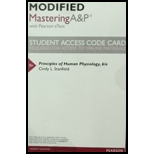
Concept explainers
Introduction:
The cardiac cycle refers to the functioning of the human heart from the start of one heartbeat to the start of the next. It comprises of two phases: one during which the muscles of the heart is refilled with blood and relaxes, known as diastole, succeeded by the duration of strong pumping and contraction of blood, known as systole.
Answer to Problem 1E
Solution:
The correct answer is option (a) immediately after closure of the aortic semilunar valve.
Explanation of Solution
Explanation/justification for the correct answer:
Option (a) immediately after closure of the aortic semilunar valve. At the time of the immediate closure of the aortic semilunar valve, the pressure in the aorta diminishes. At the same time, the blood from the aorta flows via the blood vessels, so the blood in the aorta gets diminished resulting in the diastolic pressure. As the minimum aortic pressure is obtained, the immediate closure of the aortic semilunar valves occurs. So, the correct answer is option (a).
Explanation for the incorrect answer:
Option (b) immediately before the opening of the aortic semilunar valve. Immediately prior to the opening of the aortic semilunar valve, the systolic pressure takes place, thus, the pressure in the aorta enhances. Therefore, the mentioned option is not relevant to the given question. So, this is an incorrect option.
Option (c) immediately before the opening of the atrioventricular valves. During this time, the isovolumetric contraction occurs, and there is no involvement of the aortic pressure. Thus, the mentioned option is not relevant to the given question. So, this is an incorrect answer.
Option (d) in mid-diastole. During mid-diastole, the ventricular filling occurs, which is considered as the returning of the blood to the heart and it is known that the distribution of the blood to the blood vessels takes place via the aorta. Thus, the mentioned option is not relevant to the given question. So, this is an incorrect answer.
Option (e) at the end of systole. During the end of systole, the aortic pressure elevates. Thus, the mentioned option is not relevant to the given question. So, this is an incorrect answer.
Minimum aortic pressure during the cardiac cycle is achieved immediately after closure of the aortic semilunar valve. Hence, the correct answer is option (a) immediately after closure of the aortic semilunar valve.
Want to see more full solutions like this?
Chapter 13 Solutions
Modified Masteringa&p With Pearson Etext -- Valuepack Access Card -- For Principles Of Human Physiology
 Human Anatomy & Physiology (11th Edition)BiologyISBN:9780134580999Author:Elaine N. Marieb, Katja N. HoehnPublisher:PEARSON
Human Anatomy & Physiology (11th Edition)BiologyISBN:9780134580999Author:Elaine N. Marieb, Katja N. HoehnPublisher:PEARSON Biology 2eBiologyISBN:9781947172517Author:Matthew Douglas, Jung Choi, Mary Ann ClarkPublisher:OpenStax
Biology 2eBiologyISBN:9781947172517Author:Matthew Douglas, Jung Choi, Mary Ann ClarkPublisher:OpenStax Anatomy & PhysiologyBiologyISBN:9781259398629Author:McKinley, Michael P., O'loughlin, Valerie Dean, Bidle, Theresa StouterPublisher:Mcgraw Hill Education,
Anatomy & PhysiologyBiologyISBN:9781259398629Author:McKinley, Michael P., O'loughlin, Valerie Dean, Bidle, Theresa StouterPublisher:Mcgraw Hill Education, Molecular Biology of the Cell (Sixth Edition)BiologyISBN:9780815344322Author:Bruce Alberts, Alexander D. Johnson, Julian Lewis, David Morgan, Martin Raff, Keith Roberts, Peter WalterPublisher:W. W. Norton & Company
Molecular Biology of the Cell (Sixth Edition)BiologyISBN:9780815344322Author:Bruce Alberts, Alexander D. Johnson, Julian Lewis, David Morgan, Martin Raff, Keith Roberts, Peter WalterPublisher:W. W. Norton & Company Laboratory Manual For Human Anatomy & PhysiologyBiologyISBN:9781260159363Author:Martin, Terry R., Prentice-craver, CynthiaPublisher:McGraw-Hill Publishing Co.
Laboratory Manual For Human Anatomy & PhysiologyBiologyISBN:9781260159363Author:Martin, Terry R., Prentice-craver, CynthiaPublisher:McGraw-Hill Publishing Co. Inquiry Into Life (16th Edition)BiologyISBN:9781260231700Author:Sylvia S. Mader, Michael WindelspechtPublisher:McGraw Hill Education
Inquiry Into Life (16th Edition)BiologyISBN:9781260231700Author:Sylvia S. Mader, Michael WindelspechtPublisher:McGraw Hill Education





